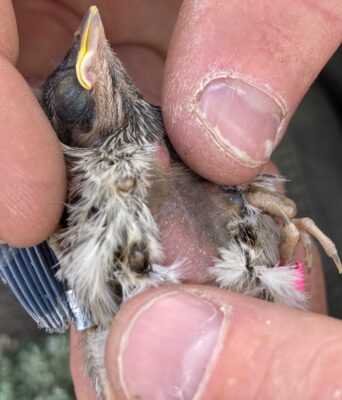Parasites can affect the fitness of host organisms in a variety of different ways, but the extent of impacts are unknown for many species. While parasites and their hosts have often evolved over long periods of time to coexist in relatively stable relationships, human-induced rapid environmental change (HIREC) threatens to upset this balance in many systems. Changes to habitat may result in higher parasite loads either by increasing parasite abundance or by making hosts more susceptible to their negative effects. Because parasite prevalence is often dependent on weather conditions, climate change has the potential to increase local abundance and expand the range of some parasites.
In the Upper Green River Basin of western Wyoming, long-term nest monitoring research conducted by the Chalfoun Lab has revealed high and apparently increasing rates of bird blow flies infecting the nests of Sagebrush Sparrow (Artemisiospiza nevadensis), Brewer’s Sparrow (Spizella brewerii), and Sage Thrasher (Oreoscoptes montanus). All three of these sagebrush-obligate songbirds are classified as Species of Greatest Conservation Need by the Wyoming Game and Fish Department. Bird blow flies (Diptera: Calliphoridae) are ectoparasites that lay their eggs in the nests of birds and, as larvae, burrow into the flesh of the nestlings and feed on their blood. The conditions leading to high infection rates in this system are unknown, and the effects of bird blow flies on sagebrush songbirds have not been well-studied.
This project seeks to answer three primary questions:
- How prevalent is blowfly parasitism in the nests of Brewer’s Sparrow, Sagebrush Sparrow, and Sage Thrasher in the Upper Green River Basin?
- How does parasitism vary temporally and spatially, and what environmental factors are associated with that variation?
- How does parasitism influence nestling growth, physical condition, and post-fledging survival?
We will collect field data in 2022 and 2023, and to use existing data from three years of previous research, to address these questions. Our methods consist of nest searching and monitoring, recording morphomethric measurements and blow fly larval counts of nestling birds to determine nestling growth and condition, and color banding and radio telemetry tracking of nestling birds to determine post-fledging survival.
Understanding the mechanisms that influence breeding success of declining sagebrush songbirds is critical to effectively design management and conservation strategies for these species. Determining the effect of weather on parasite loads could have important implications given current and future changes in climate. Better understanding how stressors effect parasite-host interactions is also key to understanding the effects of oil and gas development on wildlife in general and sagebrush-obligate songbirds in particular.


Contact
Don Jones
Master’s student, Chalfoun Lab
Department of Zoology and Physiology=
Wyoming Cooperative Wildlife Research Unit
University of Wyoming
djones46@uwyo.edu
Project Lead
Don Jones joined the Chalfoun Lab in 2022 as a Master’s student studying the prevalence and effects of parasites on sagebrush songbird nestlings in the Upper Green River Basin near Pinedale, WY. Don is a Wyoming native who attended Middlebury College in Vermont and graduated with a B.S. in Conservation Biology and Environmental Studies in 2017. MORE »

Funding & Partners
- U.S. Fish and Wildlife Service
- Wyoming Game and Fish Department
- Meg and Bert Raynes Wildlife Fund
